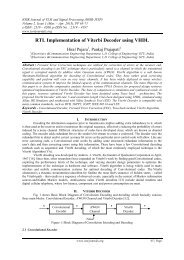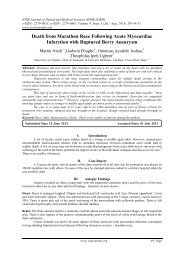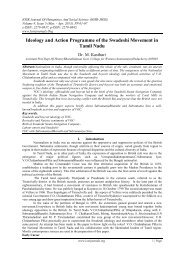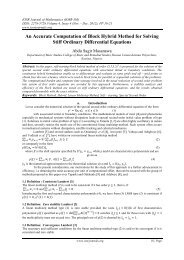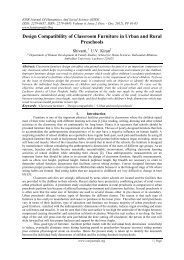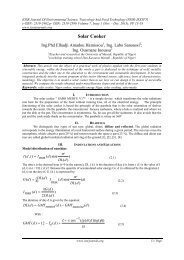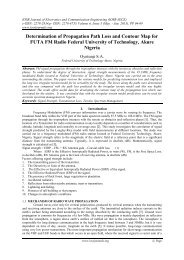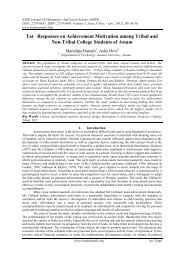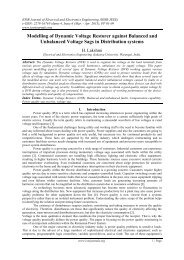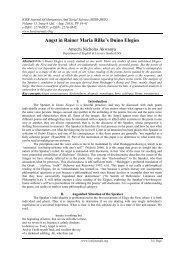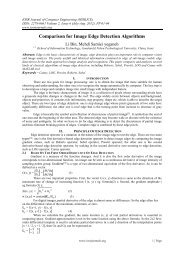Sonographic evaluation of the Amniotic Fluid Index in normal ... - IOSR
Sonographic evaluation of the Amniotic Fluid Index in normal ... - IOSR
Sonographic evaluation of the Amniotic Fluid Index in normal ... - IOSR
You also want an ePaper? Increase the reach of your titles
YUMPU automatically turns print PDFs into web optimized ePapers that Google loves.
<strong>IOSR</strong> Journal <strong>of</strong> Dental and Medical Sciences (<strong>IOSR</strong>-JDMS)<br />
e-ISSN: 2279-0853, p-ISSN: 2279-0861. Volume 6, Issue 3 (May.- Jun. 2013), PP 29-33<br />
www.iosrjournals.org<br />
<strong>Sonographic</strong> <strong>evaluation</strong> <strong>of</strong> <strong>the</strong> <strong>Amniotic</strong> <strong>Fluid</strong> <strong>Index</strong> <strong>in</strong> <strong>normal</strong><br />
s<strong>in</strong>gleton pregnancies <strong>in</strong> a Nigerian population.<br />
Igb<strong>in</strong>idu E 1 , Akhigbe AO 2 , Ak<strong>in</strong>ola RA 3<br />
1 (Radiology Department, College <strong>of</strong> Medic<strong>in</strong>e, University <strong>of</strong> Ben<strong>in</strong> Teach<strong>in</strong>g Hospital, Ben<strong>in</strong> City, Nigeria)<br />
2 (Radiology Department, College <strong>of</strong> Medic<strong>in</strong>e, University <strong>of</strong> Ben<strong>in</strong> Teach<strong>in</strong>g Hospital, Ben<strong>in</strong> City, Nigeria)<br />
3 (Radiology Department, College <strong>of</strong> Medic<strong>in</strong>e, Lagos State University Teach<strong>in</strong>g Hospital, Ikeja, Nigeria)<br />
Abstract: Estimation <strong>of</strong> amniotic fluid volume is an <strong>in</strong>tegral part <strong>of</strong> <strong>the</strong> rout<strong>in</strong>e obstetric ultrasound scan and<br />
<strong>the</strong> amniotic fluid <strong>in</strong>dex (AFI) is one <strong>of</strong> <strong>the</strong> methods for do<strong>in</strong>g this. Reduction or excessive production <strong>of</strong><br />
amniotic fluid dur<strong>in</strong>g pregnancy is also a strong predictor <strong>of</strong> possible associated congenital fetal anomaly. This<br />
study was to assess <strong>the</strong> AFI <strong>in</strong> Nigerian women and correlate same with <strong>the</strong>ir gestational age. It is a prospective<br />
cross sectional study <strong>of</strong> 300 scanned s<strong>in</strong>gleton pregnancies between 15-42 gestational ages. Their amniotic fluid<br />
<strong>in</strong>dices were determ<strong>in</strong>ed and correlated with <strong>the</strong>ir gestational age. A statistical analysis <strong>of</strong> data was done us<strong>in</strong>g<br />
<strong>the</strong> SPSS version 16, Chicago, Ill<strong>in</strong>ois. The study population mean AFI was 12.91±4.82cm, rang<strong>in</strong>g from 4.17 –<br />
22.05cm and a median <strong>of</strong> 12.56; <strong>the</strong> 5 th and 95 th percentile be<strong>in</strong>g 5.81 and 21.95 respectively. The mean AFI for<br />
preterm and term gestations were 12.70±5.02cm and 14.07±3.34cm respectively. There was no statistically<br />
significant difference between <strong>the</strong> mean AFI <strong>of</strong> <strong>the</strong> total study population and that <strong>of</strong> preterm and term<br />
gestations. The peak mean AFI value occurred at 28 weeks gestational age, with no bias <strong>in</strong> <strong>the</strong> distribution <strong>of</strong><br />
amniotic fluid <strong>in</strong> <strong>the</strong> four quadrants <strong>of</strong> <strong>the</strong> uterus. Apart from establish<strong>in</strong>g <strong>the</strong> <strong>normal</strong> AFI values <strong>in</strong> this<br />
environment, this study also showed that <strong>the</strong>re was a weak positive correlation between gestational age and<br />
AFI, with no statistically significant difference <strong>in</strong> AFI <strong>of</strong> preterm and term gestations.<br />
Key Words: <strong>Amniotic</strong> fluid <strong>in</strong>dex, Nigeria, S<strong>in</strong>gleton pregnancies, Ultrasound.<br />
I. Introduction<br />
<strong>Amniotic</strong> fluid surrounds <strong>the</strong> fetus throughout pregnancy provid<strong>in</strong>g its nutrition, support and warmth. It<br />
also helps <strong>in</strong> <strong>the</strong> development <strong>of</strong> <strong>the</strong> fetal lungs. The possible sources <strong>of</strong> amniotic fluid <strong>in</strong> <strong>the</strong> first trimester<br />
<strong>in</strong>clude a transudate <strong>of</strong> maternal plasma through <strong>the</strong> chorioamnion, or from fetal plasma through <strong>the</strong> highly<br />
permeable fetal sk<strong>in</strong>, prior to kerat<strong>in</strong>ization[1,2]. In <strong>the</strong> second and third trimesters <strong>of</strong> pregnancy, amniotic fluid<br />
volume is ma<strong>in</strong>ta<strong>in</strong>ed by a balance <strong>of</strong> fetal fluid production <strong>in</strong> lung fluid and ur<strong>in</strong>e, as well as fluid resorption <strong>in</strong><br />
fetal swallow<strong>in</strong>g and flow across <strong>the</strong> fetal membranes to <strong>the</strong> uterus[2,3]. Normal amniotic fluid volume varies<br />
with gestational age[4].<br />
The amniotic fluid volume is an important marker <strong>of</strong> <strong>in</strong>trauter<strong>in</strong>e fetal wellbe<strong>in</strong>g, hence its<br />
quantification serves as a means <strong>of</strong> assess<strong>in</strong>g fetal status[2,3,5,6,7,8]. and <strong>the</strong> AFI technique is a rapid, readily<br />
reproducible, non-<strong>in</strong>vasive method <strong>of</strong> determ<strong>in</strong><strong>in</strong>g <strong>the</strong> amniotic fluid volume that was developed by Phelan and<br />
his colleagues[9]. It is calculated sonographically by <strong>the</strong> summation <strong>of</strong> <strong>the</strong> values <strong>of</strong> <strong>the</strong> vertical height <strong>of</strong> <strong>the</strong><br />
largest amniotic fluid pockets (exclud<strong>in</strong>g umbilical cord and fetal parts) <strong>in</strong> each <strong>of</strong> <strong>the</strong> four quadrants <strong>of</strong> <strong>the</strong><br />
gravid uterus, expressed <strong>in</strong> centimeters[9]. Its validity has been demonstrated by Moore and Cayle[10] as well<br />
as o<strong>the</strong>r authors[11]. Establish<strong>in</strong>g <strong>normal</strong> values <strong>of</strong> <strong>the</strong> amniotic fluid volume for a given population will help <strong>in</strong><br />
identify<strong>in</strong>g oligohydramnnios and polyhydramnios and <strong>the</strong>ir attend<strong>in</strong>g complications.<br />
Oligohydramnios has been def<strong>in</strong>ed as an amniotic fluid volume that is ab<strong>normal</strong>ly low for gestational<br />
age or a volume <strong>of</strong> less than 500 ml at term, while polyhydramnios is amniotic fluid volume greater than<br />
<strong>normal</strong> for gestational age or 2000 ml or more at term[5,12]. Oligohydramnios is associated with small for<br />
gestational age fetus, renal anomalies and ur<strong>in</strong>ary tract dysplasias[5] while polyhydramnios may be associated<br />
with fetal neural tube defects, central nervous system ab<strong>normal</strong>ities affect<strong>in</strong>g fetal swallow<strong>in</strong>g, gastro<strong>in</strong>test<strong>in</strong>al<br />
obstructions, <strong>in</strong>fections, isoimmunisation, gestational diabetes mellitus, non-immune fetal hydrops,<br />
chorioangioma <strong>of</strong> <strong>the</strong> placenta, and pulmonary hypoplasia[6,13,14].<br />
Nigeria be<strong>in</strong>g <strong>the</strong> most populous black nation on earth, has a relatively diverse and heterogeneous<br />
population[15].<br />
In this study <strong>the</strong> AFI among Nigerian women with uncomplicated s<strong>in</strong>gleton pregnancies was<br />
determ<strong>in</strong>ed, and its variation with gestational age was also assessed.<br />
www.iosrjournals.org<br />
29 | Page
<strong>Sonographic</strong> <strong>evaluation</strong> <strong>of</strong> <strong>the</strong> <strong>Amniotic</strong> <strong>Fluid</strong> <strong>Index</strong> <strong>in</strong> <strong>normal</strong> s<strong>in</strong>gleton pregnancies <strong>in</strong> a Nigerian<br />
II. Materials And Methods<br />
This was a prospective cross sectional study <strong>in</strong>volv<strong>in</strong>g 300 pregnant women whose amniotic fluid<br />
<strong>in</strong>dices were determ<strong>in</strong>ed. It was conducted over a 12-month period us<strong>in</strong>g a portable Titan R 2.5 (Sonosite Inc,<br />
USA. 2004) mach<strong>in</strong>e with a curvil<strong>in</strong>ear 3.5 MHz transducer.<br />
2.1 Sett<strong>in</strong>g and Study design: The study center was <strong>the</strong> Radiology department <strong>of</strong> a University Teach<strong>in</strong>g<br />
Hospital <strong>in</strong> Nigeria where approval was granted by <strong>the</strong> Research and Ethics committee and <strong>the</strong> procedures<br />
followed were <strong>in</strong> accordance with <strong>the</strong> ethical standards <strong>of</strong> <strong>the</strong> Hels<strong>in</strong>ki Declaration.<br />
The study subjects were those referred for rout<strong>in</strong>e obstetric ultrasound scann<strong>in</strong>g from <strong>the</strong> antenatal<br />
cl<strong>in</strong>ic <strong>of</strong> <strong>the</strong> Obstetrics and Gynaecology Department and <strong>the</strong> General Practice Cl<strong>in</strong>ic who were between 15 – 42<br />
weeks gestational age, with <strong>normal</strong> s<strong>in</strong>gleton pregnancies. Written <strong>in</strong>formed consent was obta<strong>in</strong>ed from <strong>the</strong><br />
study subjects after <strong>the</strong> study and its procedure had been adequately expla<strong>in</strong>ed to <strong>the</strong>m.<br />
Their gestational age was calculated from <strong>the</strong> first day <strong>of</strong> <strong>the</strong> last <strong>normal</strong> menstrual period us<strong>in</strong>g <strong>the</strong><br />
cl<strong>in</strong>ical history given or from a previous first trimester ultrasound scan. Subjects with complicated pregnancies,<br />
women who have suspected or previously confirmed polyhydramnios, oligohydramnios or <strong>in</strong>tra uter<strong>in</strong>e growth<br />
restriction <strong>in</strong> <strong>the</strong> <strong>in</strong>dex pregnancy, women with multiple gestations and women who were unsure <strong>of</strong> <strong>the</strong>ir dates<br />
were excluded from <strong>the</strong> study.<br />
The study subjects were scanned <strong>in</strong> <strong>the</strong> sup<strong>in</strong>e position with <strong>the</strong> head propped up us<strong>in</strong>g a pillow to<br />
make <strong>the</strong>m comfortable. The gravid uterus was divided <strong>in</strong>to four quadrants us<strong>in</strong>g <strong>the</strong> l<strong>in</strong>ear nigra and <strong>the</strong><br />
umbilicus as <strong>the</strong> vertical and horizontal reference po<strong>in</strong>ts respectively. In pregnancies less than 24 weeks, <strong>the</strong><br />
uterus was divided <strong>in</strong>to two halves us<strong>in</strong>g <strong>the</strong> l<strong>in</strong>ear nigra as <strong>the</strong> reference po<strong>in</strong>t. The ultrasound probe was<br />
applied to <strong>the</strong> abdomen perpendicular to <strong>the</strong> abdom<strong>in</strong>al sk<strong>in</strong> and <strong>in</strong> <strong>the</strong> long axis <strong>of</strong> <strong>the</strong> patient. Gentle pressure<br />
was applied throughout <strong>the</strong> exam<strong>in</strong>ation and each patient was scanned at a s<strong>in</strong>gle visit only.<br />
The largest amniotic fluid pockets <strong>in</strong> each quadrant were identified and <strong>the</strong> vertical diameter (<strong>in</strong><br />
centimeters) were measured after mak<strong>in</strong>g sure that <strong>the</strong>re were no fetal parts or loops <strong>of</strong> umbilical cords with<strong>in</strong><br />
<strong>the</strong> pool. The dimensions measured for each <strong>of</strong> <strong>the</strong> four quadrants were <strong>the</strong>n added up to give <strong>the</strong> amniotic fluid<br />
<strong>in</strong>dex. Each dimension was measured thrice and <strong>the</strong> average was taken for accuracy.<br />
2.2 Statistics and Data analysis: The AFI values measured, biophysical <strong>in</strong>formation and all o<strong>the</strong>r data collected<br />
from each patient were recorded and entered <strong>in</strong>to <strong>the</strong> patient’s data form. These were <strong>the</strong>n coded and transferred<br />
<strong>in</strong>to a computer spreadsheet us<strong>in</strong>g Micros<strong>of</strong>t excel 2007(Micros<strong>of</strong>t Inc. USA) and Statistical Package for Social<br />
Sciences (SPSS) Chicago, Ill<strong>in</strong>ois, version 16.0. Paired t-test and o<strong>the</strong>r analysis were performed to compare<br />
between groups. For <strong>the</strong> graphics tables, figures, Micros<strong>of</strong>t excel were used. The entire statistical calculations<br />
were performed at <strong>the</strong> 95% confidence <strong>in</strong>terval.<br />
III. Results<br />
The age range <strong>of</strong> <strong>the</strong> study subjects was 18-45 years with a mean age <strong>of</strong> 29.78±4.48 years and median<br />
age <strong>of</strong> 30 years, while <strong>the</strong> gestational age was 15 - 42 weeks. The subjects’ gravidity was from 1 to 8 with a<br />
mean <strong>of</strong> 3.03±1.49. Those who were gravida 3 had <strong>the</strong> highest frequency (31%). The m<strong>in</strong>imum parity was 0<br />
while <strong>the</strong> maximum was 5 with a mean <strong>of</strong> 1.34±1.15. Less than half <strong>of</strong> <strong>the</strong> study group was Primipara, 35%,<br />
Table 1, though <strong>the</strong>y were <strong>the</strong> most frequent.<br />
Table 1 show<strong>in</strong>g frequency distribution <strong>of</strong> patients’ age group with parity.<br />
www.iosrjournals.org<br />
30 | Page
<strong>Sonographic</strong> <strong>evaluation</strong> <strong>of</strong> <strong>the</strong> <strong>Amniotic</strong> <strong>Fluid</strong> <strong>Index</strong> <strong>in</strong> <strong>normal</strong> s<strong>in</strong>gleton pregnancies <strong>in</strong> a Nigerian<br />
Just over a quarter <strong>of</strong> <strong>the</strong> study subjects were between <strong>the</strong> 25 – 29 weeks gestational age and <strong>the</strong>y were <strong>the</strong><br />
most frequent while <strong>the</strong> least frequent were those 40 weeks and above gestation age, 6.7%. The range <strong>of</strong> mean<br />
AFI across gestation <strong>in</strong> this study was 4.17-22.05. The mean amniotic fluid <strong>in</strong>dex (AFI) for preterm ( 0.05). There was also no statistically significant difference between <strong>the</strong> AFI <strong>in</strong><br />
<strong>the</strong> preterm gestation compared to that <strong>in</strong> term gestation.<br />
Comparison <strong>of</strong> <strong>the</strong> mean vertical pockets <strong>of</strong> amniotic fluid <strong>in</strong> <strong>the</strong> different quadrants showed that <strong>the</strong>re was<br />
no significant difference amongst <strong>the</strong> different quadrants.<br />
Fig. 1:<br />
Graph show<strong>in</strong>g <strong>the</strong> variation <strong>of</strong> AFI with gestational age.<br />
Table 2: Gestational age range and mean AFI <strong>in</strong> <strong>the</strong> study population<br />
3.1 Variation <strong>of</strong> AFI with gestational age<br />
The amniotic fluid <strong>in</strong>dex <strong>in</strong> this study was found to rise steadily from 15-19 weeks gestational age<br />
group through <strong>the</strong> 20-24 weeks age group, reach<strong>in</strong>g a peak <strong>in</strong> <strong>the</strong> 25-29 weeks gestational age group. Thereafter,<br />
<strong>the</strong> AFI values dropped <strong>in</strong> <strong>the</strong> 30-34 weeks gestational age group, rema<strong>in</strong><strong>in</strong>g constant <strong>in</strong> <strong>the</strong> 35-39 weeks<br />
gestational age group after which it rises aga<strong>in</strong> <strong>in</strong> <strong>the</strong> 40-42 weeks gestational age group. Overall <strong>the</strong>re was a<br />
weak positive correlation between gestational age and AFI, Fig. 1.<br />
IV. Discussion<br />
The amniotic fluid plays a vital role <strong>in</strong> fetal nutrition and protection dur<strong>in</strong>g <strong>in</strong>tra uter<strong>in</strong>e life, <strong>the</strong>refore<br />
its volume is rout<strong>in</strong>ely estimated as part <strong>of</strong> <strong>the</strong> obstetric ultrasound scan. In <strong>the</strong> second and third trimesters,<br />
amniotic fluid is produced by fetal lung secretions and fetal ur<strong>in</strong>e while it is resorbed by fetal swallow<strong>in</strong>g and<br />
flow across fetal membranes to <strong>the</strong> uterus. A defect <strong>in</strong> any <strong>of</strong> <strong>the</strong> above processes can <strong>the</strong>refore lead to<br />
ab<strong>normal</strong> amniotic fluid volumes. The estimation <strong>of</strong> <strong>the</strong> amniotic fluid volume can ultimately serve as an<br />
<strong>in</strong>dicator <strong>of</strong> possible congenital anomaly with consequent poor pregnancy outcome. Its assessment is <strong>the</strong>refore<br />
www.iosrjournals.org<br />
31 | Page
<strong>Sonographic</strong> <strong>evaluation</strong> <strong>of</strong> <strong>the</strong> <strong>Amniotic</strong> <strong>Fluid</strong> <strong>Index</strong> <strong>in</strong> <strong>normal</strong> s<strong>in</strong>gleton pregnancies <strong>in</strong> a Nigerian<br />
an <strong>in</strong>tegral part <strong>of</strong> <strong>the</strong> obstetrician’s decision tak<strong>in</strong>g on obstetric management and consequent pregnancy<br />
outcome, fetal and maternal mortality and morbidity and <strong>of</strong> course, safe mo<strong>the</strong>rhood.<br />
The mean AFI <strong>in</strong> this study was similar to that reported by o<strong>the</strong>r workers <strong>in</strong> both African and<br />
Caucasian populations[4,8,16]. The AFI <strong>in</strong> this study <strong>in</strong>creased steadily until it reached a peak at 28 weeks<br />
before gradually decl<strong>in</strong><strong>in</strong>g at 30 weeks, follow<strong>in</strong>g which it rema<strong>in</strong>ed relatively constant before ris<strong>in</strong>g aga<strong>in</strong> to<br />
reach ano<strong>the</strong>r peak at 40 weeks. After 40 weeks, <strong>the</strong> AFI started to decl<strong>in</strong>e. The peak values <strong>of</strong> mean amniotic<br />
fluid <strong>in</strong>dex <strong>in</strong> this study were reached at 28 and 40 weeks gestation and <strong>the</strong> difference was not statistically<br />
significant, suggest<strong>in</strong>g that <strong>the</strong> AFI did not change much between 28 weeks and 40 weeks. This f<strong>in</strong>d<strong>in</strong>g was<br />
similar to those <strong>of</strong> Brace and Wolf[4], Alao et al[8] and Ott WJ[17] Alao et al[8] <strong>in</strong> <strong>the</strong>ir study <strong>in</strong> a western<br />
Nigerian population found that <strong>the</strong>re was no statistically significant difference <strong>in</strong> <strong>the</strong> mean AFI between preterm<br />
and term gestations. This was also <strong>in</strong> keep<strong>in</strong>g with <strong>the</strong> f<strong>in</strong>d<strong>in</strong>gs <strong>of</strong> Brace and Wolf[4] who concluded that <strong>the</strong>re<br />
was no difference <strong>in</strong> <strong>the</strong> amniotic fluid <strong>in</strong>dex at 22 weeks and at 39 weeks gestation. However <strong>the</strong> values<br />
obta<strong>in</strong>ed <strong>in</strong> <strong>the</strong> present study were lower than those <strong>of</strong> Alao et al[8] The mean AFI for <strong>the</strong> preterm and term<br />
gestation <strong>in</strong> our study were 12.70±5.02 and 14.07±3.34 respectively, compared to 15.41±4.08 and 15.32 ± 4.35<br />
<strong>in</strong> <strong>the</strong>ir study with a range <strong>in</strong> <strong>of</strong> 4.17 – 22.05 <strong>in</strong> our study and 7.90 -27.30 <strong>in</strong> <strong>the</strong>ir study.<br />
The mechanisms that ma<strong>in</strong>ta<strong>in</strong> amniotic fluid volume are fairly well understood from <strong>the</strong> second<br />
trimester onwards. The fetal kidneys are <strong>the</strong> major source <strong>of</strong> amniotic fluid production after <strong>the</strong> 10 th – 12 th week<br />
<strong>of</strong> gestation till term[12,13,18,19]. This is done by means <strong>of</strong> fetal ur<strong>in</strong>e production. Fetal ur<strong>in</strong>e production is<br />
said to <strong>in</strong>crease 10-folds between 20 – 40 weeks <strong>of</strong> gestation[20], with rates <strong>of</strong> 400-1200ml/day documented at<br />
term[2,16,18,21]. The <strong>in</strong>itial gradual rise <strong>of</strong> <strong>the</strong> amniotic fluid <strong>in</strong>dex noted <strong>in</strong> this study could be attributed to <strong>the</strong><br />
<strong>in</strong>creas<strong>in</strong>g rate <strong>of</strong> ur<strong>in</strong>e production by <strong>the</strong> fetal kidneys with <strong>in</strong>creas<strong>in</strong>g maturity. Fetal lung fluid production is a<br />
m<strong>in</strong>or contributor to <strong>the</strong> amniotic fluid volume and it is usually maximal near term due to <strong>in</strong>creased maturity <strong>of</strong><br />
<strong>the</strong> lungs at term[5,13,18]. This may also partially expla<strong>in</strong> <strong>the</strong> second peak <strong>in</strong> AFI at term. However, s<strong>in</strong>ce <strong>the</strong><br />
amniotic fluid volume is determ<strong>in</strong>ed by factors that affect production and resorption, fetal swallow<strong>in</strong>g,<br />
transmembranous and <strong>in</strong>tramembranous absorption, which are <strong>the</strong> ma<strong>in</strong> routes <strong>of</strong> removal <strong>of</strong> amniotic fluid,<br />
<strong>the</strong>se def<strong>in</strong>itely have significant roles <strong>in</strong> ultimately determ<strong>in</strong><strong>in</strong>g <strong>the</strong> amniotic fluid <strong>in</strong>dex. Fetal swallow<strong>in</strong>g<br />
accounts for about half <strong>of</strong> <strong>the</strong> total amount <strong>of</strong> fluid removed[13,14,18,19]. After 40 weeks <strong>the</strong> fetal ur<strong>in</strong>e<br />
production wanes as a result <strong>of</strong> decreas<strong>in</strong>g fetal growth and decreas<strong>in</strong>g placental function hence <strong>the</strong> gradual drop<br />
<strong>in</strong> AFI noted <strong>in</strong> this study after 40 weeks gestation[1,13,14,18,19].<br />
While various studies[5,14] recorded <strong>the</strong>ir peak AFI values at <strong>the</strong> 26 th week <strong>of</strong> gestation, <strong>the</strong> peak mean<br />
AFI value <strong>in</strong> <strong>the</strong> present study was recorded at <strong>the</strong> 28 th week <strong>of</strong> gestation. Salahudd<strong>in</strong> et al[22] us<strong>in</strong>g a<br />
longitud<strong>in</strong>al study obta<strong>in</strong>ed peak AFI values amongst Japanese women at 30 weeks gestation, and Birang[19]<br />
arrived at a peak mean AFI value at 27 weeks gestation <strong>in</strong> an Iranian population.<br />
The variation <strong>of</strong> amniotic fluid <strong>in</strong>dex with gestational age <strong>in</strong> this study was quite different from <strong>the</strong><br />
trend observed by Moore and Cayle[10] and several o<strong>the</strong>r workers who reported that <strong>the</strong> amniotic fluid <strong>in</strong>dex<br />
values for each week <strong>of</strong> gestation were specific for <strong>the</strong> gestational age. Therefore, <strong>the</strong>re is a need to match <strong>the</strong><br />
amniotic fluid <strong>in</strong>dex values to specific weeks <strong>of</strong> gestation. The difference <strong>in</strong> this f<strong>in</strong>d<strong>in</strong>g may be due to racial<br />
and environmental factors, a reason<strong>in</strong>g which is buttressed by <strong>the</strong> fact that two previous studies carried out <strong>in</strong><br />
sou<strong>the</strong>rn Nigeria[8] and nor<strong>the</strong>rn Nigeria[14] were at variance. Nigeria is a relatively heterogenous country and<br />
<strong>the</strong>se studies were carried out <strong>in</strong> relatively geographically dist<strong>in</strong>ct parts <strong>of</strong> <strong>the</strong> country. The present study was<br />
done <strong>in</strong> south - south Nigeria and <strong>the</strong> f<strong>in</strong>d<strong>in</strong>gs were also more similar to those <strong>of</strong> <strong>the</strong> south western study.<br />
A feature that is common to most o<strong>the</strong>r studies <strong>of</strong> amniotic fluid <strong>in</strong>dex is that <strong>the</strong>re is a wide variation<br />
<strong>of</strong> “<strong>normal</strong>” AFI values with<strong>in</strong> <strong>the</strong> same gestational week throughout pregnancy. This f<strong>in</strong>d<strong>in</strong>g is not surpris<strong>in</strong>g<br />
though, as Brace and Wolf[4] had documented a wide variation <strong>in</strong> amniotic fluid volume at each gestational<br />
week <strong>in</strong> <strong>the</strong>ir study. However, <strong>the</strong>y noted that despite <strong>the</strong> wide variation <strong>in</strong> amniotic fluid volume at each<br />
gestational week, <strong>the</strong> average amniotic fluid volume did not change significantly between 22 weeks and term.<br />
This may also partly expla<strong>in</strong> why <strong>the</strong>re was no statistically significant difference <strong>in</strong> AFI <strong>of</strong> preterm and term<br />
gestations <strong>in</strong> this study.<br />
In <strong>the</strong> present study, subjects with an amniotic fluid <strong>in</strong>dex <strong>of</strong> less than 4.17cm at fifteen weeks gestation to term<br />
may be regarded as hav<strong>in</strong>g oligohydramnios while those with a value <strong>of</strong> greater than 22.05 at any gestational<br />
age may be regarded as hav<strong>in</strong>g polyhydramnios. These values, though not too different from <strong>the</strong> <strong>normal</strong> range<br />
<strong>in</strong> present use (5 – 20), however provide a wider range <strong>of</strong> <strong>normal</strong> values than <strong>the</strong> present reference range. This is<br />
probably due to <strong>the</strong> trend observed <strong>in</strong> our study where <strong>the</strong> amniotic fluid <strong>in</strong>dex tends to rema<strong>in</strong> relatively stable<br />
for a longer period <strong>of</strong> gestation before eventually decl<strong>in</strong><strong>in</strong>g after 40 weeks.<br />
V. Conclusion<br />
This study has established <strong>the</strong> range <strong>of</strong> amniotic fluid <strong>in</strong>dex <strong>in</strong> this environment which will be a useful<br />
guide <strong>in</strong> <strong>the</strong> assessment <strong>of</strong> amniotic fluid volumes. The values are comparable to those found <strong>in</strong> south western<br />
Nigeria but at variance with that <strong>in</strong> Nor<strong>the</strong>rn Nigeria. We have also shown that, <strong>in</strong> this environment, <strong>the</strong><br />
www.iosrjournals.org<br />
32 | Page
<strong>Sonographic</strong> <strong>evaluation</strong> <strong>of</strong> <strong>the</strong> <strong>Amniotic</strong> <strong>Fluid</strong> <strong>Index</strong> <strong>in</strong> <strong>normal</strong> s<strong>in</strong>gleton pregnancies <strong>in</strong> a Nigerian<br />
amniotic fluid <strong>in</strong>dex does not change much from about <strong>the</strong> 25 th gestational week to term and it does not correlate<br />
with <strong>the</strong> GA as <strong>in</strong> o<strong>the</strong>r studies <strong>in</strong> literature.<br />
References<br />
[1]. D.F. Anderson, J.J. Faber, C.M. Parks, Extraplacental transfer <strong>of</strong> waters <strong>in</strong> <strong>the</strong> sheep, J Physiol, 406, 1988, 75.<br />
[2]. R.G. Michael, M.G. Erv<strong>in</strong>, D. Nova, Placental and Fetal Physiology, <strong>in</strong> G.S. Gabbe, J.R. Niebyl , J,G Simpson, Normal and Problem<br />
Pregnancies. 4 th ed. (New York: Churchill Liv<strong>in</strong>gstone Inc, 2002) 37-62.<br />
[3]. W.P. Callen, <strong>Amniotic</strong> <strong>Fluid</strong> Volume: Its Role, <strong>in</strong> Fetal Health and Disease, <strong>in</strong> W.P. Callen, Ultrasonography <strong>in</strong> Obstetrics and<br />
Gynaecology. 5 th ed. (Philadelphia: Saunders, 2008) 758-779.<br />
[4]. R.A. Brace, E.J. Wolf, Normal amniotic fluid volume changes throughout pregnancy, American Journal <strong>of</strong> Obstetrics and<br />
Gynaecology, 161(2), 1989, 382-388.<br />
[5]. D. Laughl<strong>in</strong>, A.R..Knuppel, Maternal-Placental-Fetal Unit; Fetal and Early Neonatal Physiolog, <strong>in</strong> HA Decherney & L. Nathan,<br />
Current Obstetrics and Gynaecologic Diagnosis & Treatment. 9 th ed. on CD-ROM (The Mc Graw Hill Companies Inc, 2003).<br />
[6]. A.A. Umar, A.O. Akano, G.O.G Awosanya, S.B. Lagundoye, Maximum Vertical Pocket measurement <strong>of</strong> <strong>Amniotic</strong> fluid volum,.<br />
Archives <strong>of</strong> Nigerian Medic<strong>in</strong>e and Medical Sciences, 1(2), 2004, 1-4.<br />
[7]. A.F. Chervenak, G.S. Gabbe, Obstetric Ultrasound: Assessment <strong>of</strong> Fetal Growth and Anatom, <strong>in</strong> G.S .Gabbe , J.R. Niebyl, J.L.<br />
Simpson, G.S. Gabbe, Normal and Problem Pregnancies. 4 th ed. (New York: Churchill Liv<strong>in</strong>gstone Inc, 2002) 251 -296.<br />
[8]. O.B. Alao, O.O. Ayoola, V.A. Adetiloye, A.A. Aremu, The <strong>Amniotic</strong> <strong>Fluid</strong> <strong>Index</strong> <strong>in</strong> Normal Human Pregnancies <strong>in</strong> Southwestern<br />
Nigeria, The Internet Journal <strong>of</strong> Radiology, 5( 2), 2007<br />
[9]. J.P. Phelan, M.O. Ahn, C.V. Smith, S.E. Ru<strong>the</strong>rford, E. Anderson, <strong>Amniotic</strong> <strong>Fluid</strong> <strong>Index</strong> measurements dur<strong>in</strong>g pregnancy, J Reprod<br />
Med, 32(8) 1987, 601- 604.<br />
[10]. T.R. Moore, J.E. Cayle, The amniotic fluid <strong>in</strong>dex <strong>in</strong> <strong>normal</strong> human pregnancy, Am J Obstet Gynecol, 162(5) 1990, 1168-1173.<br />
[11]. R.J. Hernandez-Herrera, M. Ochoa-Torres, D. Salazar-Garcia, B. Solis-Estrada, <strong>Amniotic</strong> <strong>Fluid</strong> <strong>Index</strong> Accuracy <strong>in</strong> Mid-Trimester,<br />
Fetal Diagn Ther 26(1), 2009 6-9.<br />
[12]. Wolfgang Dahnert, Radiology Review Manual 6 th ed. (Philadelphia: Lipp<strong>in</strong>cott William’s and Wilk<strong>in</strong>s, 2007) 997-998.<br />
[13]. E. Magann, M.G. Ross, Assessment <strong>of</strong> amniotic fluid volume, Retrieved from http://www.update.com/contents/assessment <strong>of</strong><br />
amniotic fluid volume 2010.<br />
[14]. C.M. Chama, D.M. Bobzom, M.A. Mai, A longitud<strong>in</strong>al study <strong>of</strong> amniotic fluid <strong>in</strong>dex <strong>in</strong> <strong>normal</strong> pregnancy <strong>in</strong> Nigerian women,<br />
International Journal <strong>of</strong> Gynaecology & Obstetrics, 72(3) 2001, 223-227.<br />
[15]. Nigeria. CIA; <strong>the</strong> World Fact Book onl<strong>in</strong>e. Retrieved from https://www.cia.gov/library/publications/<strong>the</strong>-world.../ni.html.<br />
[16]. C. Roger, Obstetric Ultrasound, <strong>in</strong> Sutton D. Textbook <strong>of</strong> Radiology and Imag<strong>in</strong>g. 7 th ed. (London: Churchill Liv<strong>in</strong>gstone, 2002)<br />
1039-1068.<br />
[17]. W.J. Ott, Re-<strong>evaluation</strong> <strong>of</strong> <strong>the</strong> relationship between amniotic fluid volume and per<strong>in</strong>atal outcome, Am J Obstet Gynecol. 192(6),<br />
2005, 1803-1809.<br />
[18]. Ab<strong>normal</strong>ities <strong>in</strong> <strong>Amniotic</strong> fluid volume. Retrieved from http://www.centrus.com.br/DiplomaFMF/SeriesFMF/18-<br />
23-weeks/chapter-14/ambiotic-fluid/am_fluid_01.html<br />
[19]. S.H. Birang, Ultrasonographic assessment <strong>of</strong> <strong>normal</strong> amniotic fluid <strong>in</strong>dex <strong>in</strong> a group <strong>of</strong> Iranian women, Iranian J Radiol, 5(1), 2008,<br />
31-34.<br />
[20]. R. Rab<strong>in</strong>owitz, M.T. Peters, S. Vyas, S. Campbell, K.H. Nicolaides, Measurement <strong>of</strong> fetal ur<strong>in</strong>e production <strong>in</strong> <strong>normal</strong> pregnancy by<br />
real- time ultrasonography, Am J Obstet Gynecol, 161(5,), 1989, 1264-1266.<br />
[21]. E.L. Gresham, J.H.G. Rank<strong>in</strong>, E.L Makowski, G. Meschia, F.C. Battaglia, An <strong>evaluation</strong> <strong>of</strong> fetal renal function <strong>in</strong> a chronic sheep<br />
preparation, J Cl<strong>in</strong> Invest, 51, 1977, 149-156.<br />
[22]. S. Salahudd<strong>in</strong>, Y. Noda, T. Fuj<strong>in</strong>o, C. Fujiyama, Y. Nagata, An assessment <strong>of</strong> amniotic fluid <strong>in</strong>dex among Japanese (A longitud<strong>in</strong>al<br />
study), J Matern Fetal Invest, 8, 1998, 31-34.<br />
www.iosrjournals.org<br />
33 | Page



